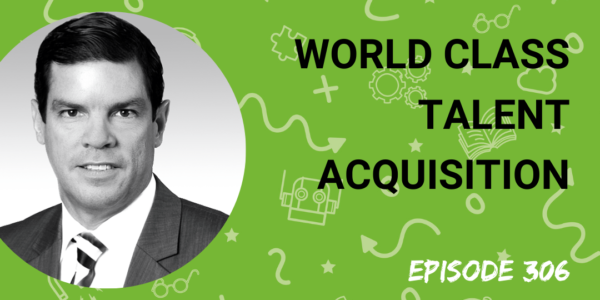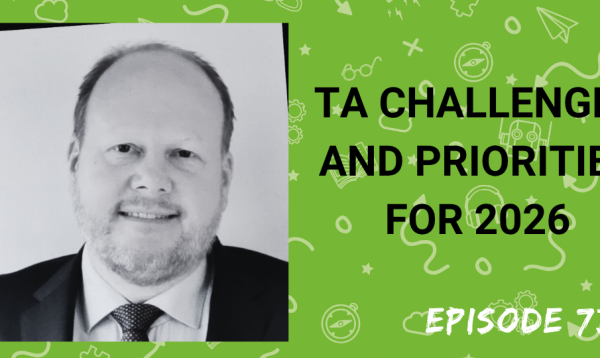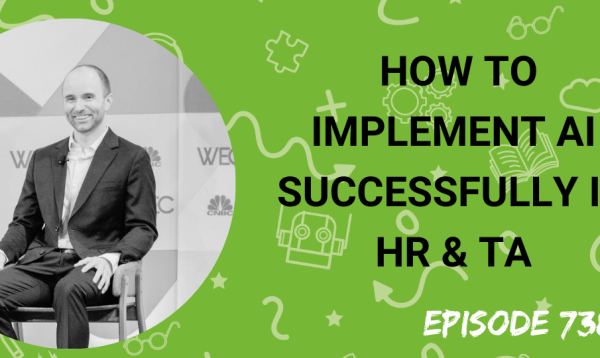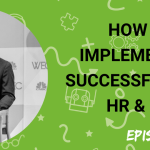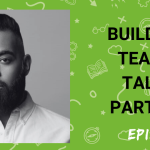As we move towards 2021, it’s increasingly evident that a paradigm shift is taking place in talent acquisition. Forced remote hiring has added rocket fuel to technology adoption, and the deep recession is driving new strategic thinking around purpose, people and process. So what does world class talent acquisition now look like and what kind of competitive advantages does it bring.
My guest this week is Harry Osle, Principal and CHRO at The Hackett Group. The Hackett Group is a strategic consultancy which benchmarks best practice within enterprises, and Harry has some unique research-driven insights to share on talent acquisition and the future of work.
In the interview, we discuss:
• How the pandemic has put HR front and centre
• Workplace, Workspace and Workmates
• Productivity in the new world of work
• The impact on Talent Acquisition
• Increased digitalisation and digital transformation
• Why world class companies are able to spend less on a per hire basis
• Driving value by keeping hires longer
• Practical advice on how to be world class at talent acquisition
Subscribe to this podcast in Apple Podcasts
Transcript:
Matt Alder [00:00:00]:
Support for this podcast is provided by Paradox, the conversational AI company helping global talent acquisition teams at Unilever, McDonald’s and CVS Health get recruiting work done faster. Let’s face it, talent acquisition is full of boring administrative tasks that drag the hiring process down and create frustrating experiences for everyone. Paradox’s AI assistant Olivia is shaking up that paradigm, automating things like applicant screening, interview scheduling and candidate Q and A so recruiters can spend more time with people, not software. Curious how Olivia can work for your team? Then visit Paradox AI to learn more.
Matt Alder [00:01:04]:
Hi everyone, this is Matt Alder. Welcome to episode 306 of the Recruiting Future podcast. As we move towards 2021, it’s increasingly clear that a paradigm shift is taking place in talent acquisition. Forced remote hiring has added rocket fuel to technology adoption and the deep rece is driving new strategic thinking around purpose, people and process. So what does world class talent acquisition now look like and what kind of competitive advantages does it bring? My guest this week is Harry Osle, principal and chro at the Hackett Group. The Hackett Group is a strategic consultancy which benchmarks best practice within enterprises and Harry has some unique research driven insights to share on talent acquisition and the future of work. Hi Harry and welcome to the podcast.
Harry Osle [00:02:08]:
Thank you Matt. Thank you for having me on the show.
Matt Alder [00:02:10]:
An absolute pleasure to have you on the show. Could you just introduce yourself and tell everyone what you do?
Harry Osle [00:02:15]:
Thank you Matt. I’m Harry Osle, I’m with the Hack Group. Been in human resources basically all my life. Came out of college and actually learned to craft for a number of years. As we started the Hacker Group, I was one of the first few employees that helped start the company and then we’ve grown here tremendously. I’m the chro of the company as well as I lead the global HR and payroll advisory programs.
Matt Alder [00:02:46]:
Now there may be some people listening who’ve not come across the work of the Hacker Group before. Could you tell us a little bit about what the company does?
Harry Osle [00:02:54]:
Matt, we’re what we call an intellectually property centric organization that helps companies drive continuous improvement. By that we’re a management consulting firm. We focus on helping companies drive improvement across all the enterprise functions, whether that’s hr, payroll, it, finance, gbs. And we do so through our intellectual property and our tremendous global talent and people that we have. The intellectual property comes from our abilities to do continuous benchmarking and Performance studies with companies. We analyze companies very, very well when we do these studies and we get to lift the covers off of these companies and know what they do well and what they don’t do so well and those things that they do very well. And we see it kind of performed across other organizations. We capture that information through best practices, through metrics, through processes, down to a level three process design. And we utilize that information to not only drive more research, but also utilize that research and that, those that understanding and that intelligence to help companies get better. Right. Every organization knows that there’s always something that they need to be working on. I always like to say that my elevator speech is, we’re fitness coaches for companies. We help companies understand what their objectives are and get them, and help them get better at those objectives.
Matt Alder [00:04:36]:
It’s fair to say that 2020 hasn’t turned out the way that anyone expected. How have the events that have gone on the pandemic, how have they changed the focus of the work that you’re doing?
Harry Osle [00:04:48]:
That’s a great question. I don’t think, I think, not to use any levity here, but I don’t think there’s anybody who came up with a projection that 2020 was going to be the way it’s turned out to be. It’s obviously been a year of incredible upheaval for individuals, for people across the world. And then obviously, as you impact those people across the world, obviously it impacts businesses. You know, I’ve seen a tremendous amount of change. And as I reflect upon that change and as it impacts people, it impacts talent, it impacts businesses. HR is at the forefront and actually at the middle of this equation. So when you speak about the changes that have occurred and whether or not companies have to go virtual, to what degree they have to go virtual, safety precautions, what supplies, masks, equipment that you have to provide, HR is at the center of all these kind of concerns and issues. So Covid and 2020 have really impacted, obviously negative, in a negative way, the, the business environment. But it’s put HR kind of at the center of the discussion. And for those organizations where HR has been a reliable business partner, a an organization who has data and information at its fingertips and can turn that data into critical thinking and decision making for the businesses, those are the organizations and HR functions that are really, really going to strive and survive. When you look at the amount of change in the workplace, I think the concept of work still remains the same. The concept of workload coming in and going through a process and then that having an impact on Productivity, the components of work are the same. So if you look at where you do work, workplace, how you know, the space that you have within the work kind of workspace, workmates, work type, work tools, work goals, all of those concepts when you look at work continue to be the same. But they’ve obviously have been impacted by Covid and specifically in 2020, I suppose.
Matt Alder [00:07:40]:
To pick up on, on one of those. To start off with the, the idea, we’ve seen many, many companies, knowledge workers in particular, having to work from home during the pandemic. Obviously that’s still very much ongoing, but we are reaching a point fairly soon in the future where companies will need to decide what their strategy is moving forward in terms of people coming back to the office or people continuing to work remotely. What’s your view on that? What do you think the long term implications are and the future looks like in terms of workplaces, office and remote work?
Harry Osle [00:08:18]:
Well, there’s two, there’s two answers that I have for you there. One, first of all, I do think that there’s an obvious impact on the workplace. When you look at the, the, my, my personal projection and when you look at some of the thought leadership around workplace, I, I think you’re going to have a third of those knowledge workers working remotely. You know, they, they do it today. There’s no real need for them to change. There’s no real need for, to have a place for them to come into work. So I think there’s going to be a third of those individuals are going to stay remote. You’re going to have a third, Matt, that’s going to be kind of a hybrid, right? They’re going to have two days on, three days into the office and then a couple of days where they work remotely. And the organization is going to be okay with that. They’re going to, they’re going to retrofit kind of the size of their office space or what have you to make sure that they can be accommodating for these kind of what I’ll call hotelers coming in and out. And then a third are going to be coming in to work as they did, you know, pre 2020. They’re going to be coming into work. They’re going to be, they need that interaction. They need some face to face time or they need, quite frankly, they just don’t have the workspace at home to be able to do that. Some, some of these decisions are going to be personal. They prefer to come in, into the office. So you can have a third, a third and A third, as it pertains to the workplace. I do believe that you have to look at the rest of the model when, when you, when you make that decision, it’s just not a, you know, a single threaded decision. Does the, does the employee have the right workspace at home? If they come into the office, can you provide the right workspace? And then the workmates discussion is around, how do they interact? So if you look at, if that third of that, you know, the knowledge workers are staying home, how are they interacting with their colleagues, how are they interacting with their clients, how they’re interacting when there’s time and need to gather information. So a lot of the implications around workplace, workspace and workmates as well as type work type work tools and goals has to do with kind of the digital aspect and the investment companies need to make to make sure that those knowledge workers, whether they’re staying at home, whether they’re hybrid and coming in and out of the office, or whether or not they’re coming into office. How do you create a better work model? Because at the end of the day, the workload will continue hopefully for a lot of organizations in that knowledge worker space, that productivity, that workload continues to come in and actually increases so we can get people, more people back to work. As that happens, that new work model, the six W’s, as I call them, will have a tremendous impact on productivity. And that’s the key most CEOs Matt, are looking at is my talent, are my people being as productive as they can be? So as these things change, as these components of the work model change, the emphasis on productivity does not. We still want to be as productive as possible. You still want to be able to get services, products out the door in a very high quality fashion quickly. So if these components are changing, then the common thread has to be how much of this can you digitize to be able to drive more efficiency and more effectiveness out of these components?
Matt Alder [00:12:13]:
What do you think the implications are for talent acquisition and recruiting?
Harry Osle [00:12:18]:
Well, that’s a, that’s a phenomenal question because as, as I, as I alluded to, HR is at the forefront, at the center of the, of the equation. Right? Because as companies needed to furlough and exit talent and people, as the downturn happened, of course we were in the center of that discussion. As we kind of normalized, HR continued to be at the, at the, at the center of that, of that equation by saying, okay, what are the things that we need to do? How do we get our people? How do we open offices Back up, how do we get our people situated? How do we get, how do we make sure that our talent and our people are safe and the well being of our people is first and foremost. So again, at the center of the equation and as companies start to re, you know, open up, as companies start to re energize, as companies start to hire again, again HR is going to be at the center of that, of that discussion. I think it has a tremendous implication on HR and specifically for those companies if you’re in the world class status and those are the companies that we believe are in the top 25 percentile in both efficiency and effectiveness or the peer group which is the medium of the rest of the database. So the middle of the 75% of the companies are not world class. If you’re in that peer group, you’re going to struggle a little bit because we don’t believe you have the right digital platforms and automation to get people number one identified, number two, interview number three selected in an efficient way and in a smart way. Efficiency is one thing, smart is another. So world class companies we believe are efficient and smart in being able to get that right talent in. So what will happen, Matt? You’re going to have the peer group companies driving recruiting and staffing you’re going to do. They’re going to do so at a, at a, at a slower clip and they’re going to do so at a less efficient rate. So I don’t believe, I believe that in the space of recruiting and staffing, world class companies are going to get even smarter and even better because they have the, the platform to do so. And I do believe that the peer groups are going to get costlier, they’re going to be slower and costlier and they’re not going to make necessarily the right hiring decisions. They’re going to hire, I believe, I think world class companies are going to hire in a more prescriptive way. They’re going to get the best of the best and they’re going to be able to identify, interview and select those people much more efficiently whereas the peer companies will not. So over time. 2020 is a baseline, but over time I think the gap only widens when it comes to recruiting and staffing. We have the numbers to prove it today.
Matt Alder [00:15:27]:
Tell us more about the numbers that you’ve got and what you’re seeing.
Harry Osle [00:15:31]:
Sure. So when you look at the world class companies, they tend to spend less on a, on a per hire basis. The importance of that, Matt, is the fact that they just don’t spend less is that they spend smarter. So when you look at their applicant tracking systems, their way to identify candidates early, they have more automation, more digitization in that area. So they spend about $1,300 on average in on a cost per hire basis for recruiting and staffing where in the overall peer group spend about $1,900 for that same process. There’s a big difference in cost. But if you look at value, the types of placements that they have, world class companies keep these hires longer than the peer group. So that’s where I go back to. I truly believe there’s going to be a big, you know, or an increase in the gap in the upcoming years because the world class companies are just better prepared today. They’re also smarter in the way they fill. So they’re faster to filling both professional and manager jobs about the same when it comes to clerical, but when it comes to professional level jobs and managers or managers being those, those people who actually manage more than one individual, they tend, these world class companies tend to fill those jobs faster. Why is that? Well, they understand the talent that they have within the organization. So they also do a better job of filling within the company as opposed to going always outside. They go outside for skill sets and competencies that they haven’t necessarily nurtured in the organization yet or they’re opening up new, new actual new roles. So that, that’s a little bit of a difference. But when it comes to filling jobs, they’re a lot smarter. And also when you look at total hires and placement per a recruiting and staffing person or FTE within the company, the world class companies place about 130 of those individuals on an annual basis where the peer group is around 80, 85 on the peer group. So you can see that not only is the process cost lower, but they’re also also being much more productive because they have, there’s a big disparity as it pertains to hires, replacements per recruiting establishment fte.
Matt Alder [00:18:17]:
As a final question, you mentioned that you see this gap getting bigger and bigger as we, as we move forward. What would your advice be to HR directors, heads of talent acquisition who aren’t in that sort of world class group in terms of what they can do right now, you know, coming out of 2020 into 2021 to, to really sort of propel themselves forward?
Harry Osle [00:18:42]:
I think that’s a. Another great question. Man. I, I really do. If I was to boil it down, I’d really look at the technology investment but not just spend money for money sake So I would think you, you, you would need to go to a, a thought process around a digital transformation. You can see you can do digital transformation by process area. So this would be smart for a head of talent to look at. It’d be smart for any kind of recruiters to take a look at, but it’d also be smart for the HR function to take a look at as a whole. And I would say that because recruiting and staffing is really the front end of the HR lifeline and employee lifecycle events, you could carve it out. But if you look at it holistically, you have to look at am I spending my technology costs as efficiently as possible. Most organizations that, as I look at the disparity between peer and world class in the upcoming years need to say I need a digital transformation blueprint to be able to say where are my gaps? Kind of a heat map around if I have all these processes, what have I across my activities in recruiting and staffing, what have I automated and what have I not and where can I get better? I think that that first question is very key. You have to look at yourself in the mirror. I’ve always said you can only get better once you understand that there’s an issue or a problem. That’s the first thing you need to do is understand where, where are my activities around recruiting and staffing, how do I identify candidates, how do I interview candidates, how do I select candidates, how do I onboard candidates? Look at those four buckets, look at the activities under those four buckets and say what have I automated and what have I haven’t? If there’s a lot of disparity in that automation process, then you have a big opportunity to probably spend wiser, to gain more efficiencies in the, in the future. This is not about necessarily spending more, it’s about spending correctly and spending wisely. And I don’t believe organizations take the time to really understand this. It’s almost, I go back to my fitness center analogy. It’s almost like some organizations run into the gym or run into the fitness center. They do a little workout and they walk out. A lot of the smart organizations understand what is it that I want to work on. Let me go into, into the fitness center, let me work on that and then let me work on my second, third and fourth issues as I go forward. And I think that’s really what it’s about. It’s really understanding where do I need help. From a technology perspective. I do believe that the digital aspect of these world class companies is driving a fundamental difference. So if you look at it from that lens and look at your activities, understand where there is opportunity, then you come up with hey, I have an issue. I need a roadmap. How do I get to that roadmap? What was the best fit? How do I get there over time?
Matt Alder [00:22:00]:
Harry, thank you very much for talking to me.
Harry Osle [00:22:02]:
Thank you Matt. Appreciate the invitation.
Matt Alder [00:22:04]:
My thanks to Harry Osle. You can subscribe to this podcast in Apple Podcasts on Spotify or via your podcasting app of choice. Please also follow us on Instagram. You can find the show by searching for Recruiting Future. You can search through all the past episodes@www.recruitingfuture.com on that site. You can also subscribe to the mailing list to get the inside track about everything that’s coming up on the show. Thanks very much for listening. I’ll be back next time and I hope you’ll join me.

